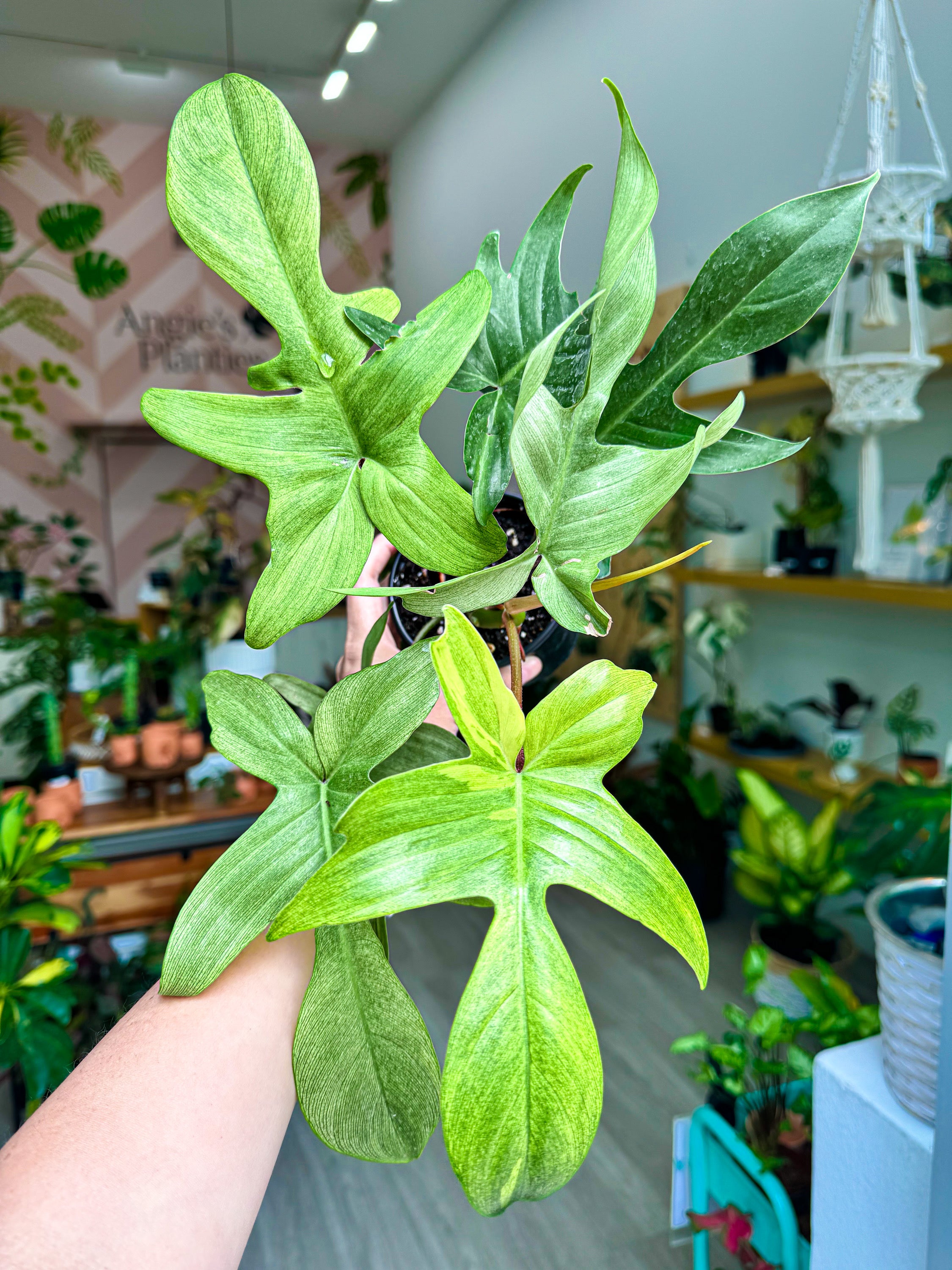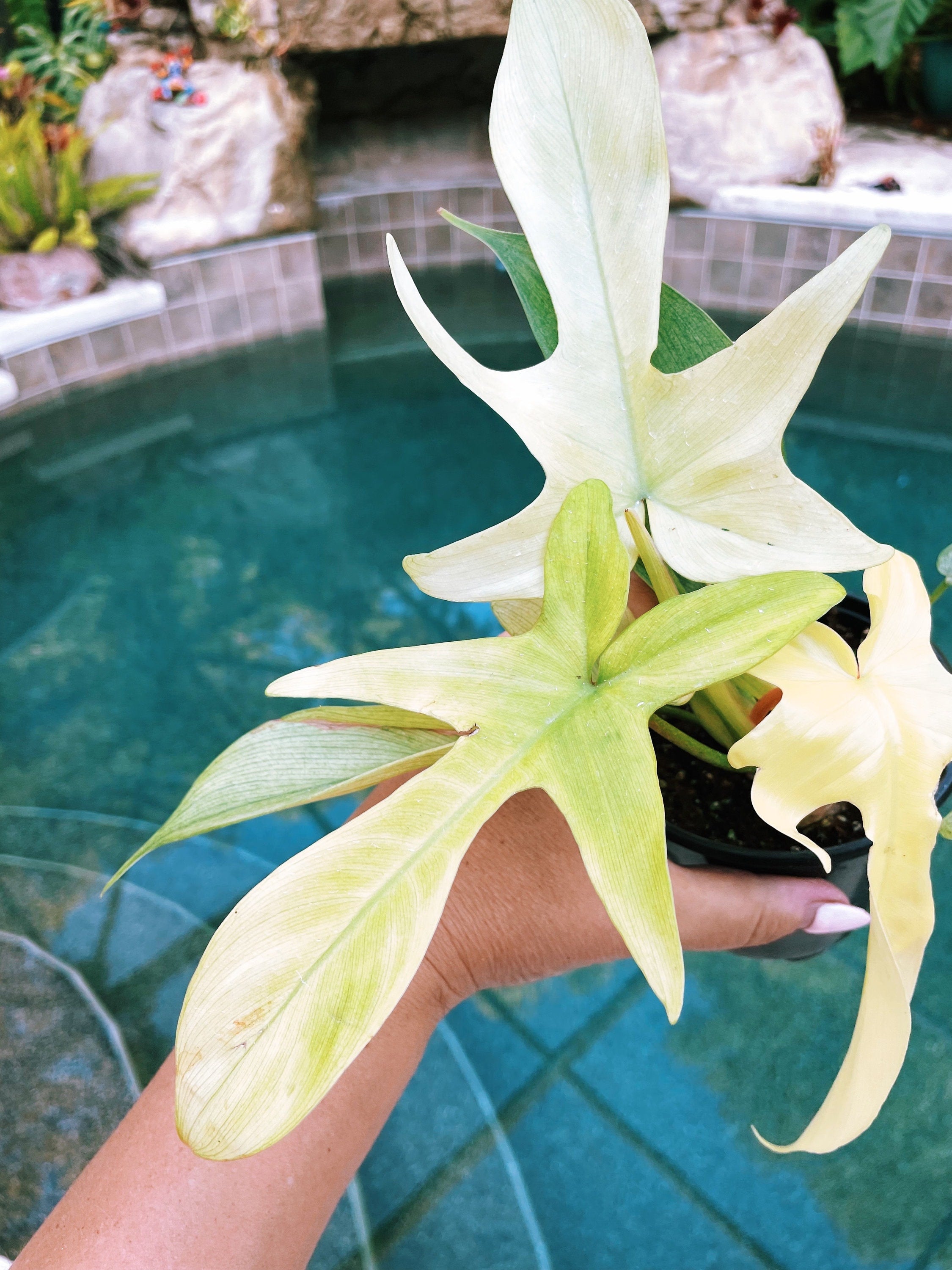Philodendron Florida ghost mint 4” pot house plant - aroid - houseplant outlets - collector plant - gift idea
Philodendron Florida ghost mint 4” pot
Philodendron Florida Ghost is a hybrid within the family Araceae and the genus Philodendron. The Philodendron genus has over 400 different species, and the exact parentage of the Florida Ghost is unclear. Still, like most Philodendrons, it makes a great house plant, which is attractive and easy to care for in most climates. Philodendrons originate from warm, humid regions in the North, Central, and South Americas where they grow in rain forests and along river banks. Extensive breeding, and cross-breeding, have resulted in the plants becoming hardier to various conditions and needing less moisture and humidity than one would expect from a tropical rainforest plant.
Philodendrons come in various shapes and sizes, from large, lobe leafed, upright plants to small trailing varieties with heart-shaped leaves. Leaf size, shape, and color also vary widely. They are perennial, evergreen plants. The Philodendron Florida Ghost variety is distinctive in leaf shape and color. The leaves emerge from red petioles as a single lobe, which is very pale, and then as they mature, they develop distinct lobes and turn from white to cream and then various shades of green until they settle as a solid, dark green when fully mature.
The largest lobe is usually oval-shaped and furthest from the stem, with smaller lobes nearer the stem, giving it the appearance of a ghost with a body, arms, and head. Combined with the pale color and the new leaves look like little, floating ghosts – hence the name!
Florida Ghost leaves may be any color from pure white outlets to cream, bright or lime green to dark green. The name Florida Ghost Mint refers to plants with leaves that are a minty color, with less yellow than the pale lime leaves. The leaves' color depends on several factors, chiefly light exposure, but Florida Ghost and Florida Ghost Mint are actually the same plant. Florida Ghost Mint is not recognized as a separate variety or cultivar to Florida Ghost.
However, many sites and nurseries sell Florida Ghost Mint as a specific plant, which has led to some confusion and some disappointment when a Florida Ghost Mint plant loses the minty color after changing growing conditions. That said, some Florida Ghost Mint plants retain the minty color even when they change conditions, and there is no exact science to keeping or losing the color. Mysterious little ghosts indeed!
In the right conditions, a Philodendron Florida Ghost will grow happily with little maintenance. Please put some thought into the initial setup, and adjust as needed after a few weeks, and from there, the plant's maintenance will be as simple as watering and occasionally feeding it.
Philodendron Florida Ghost plants are a climbing variety and need something to grow up if you want an upright plant. They can also trail from a hanging basket, but they are not a true trailing variety and tend to have fewer stems, with large leaves that grow further apart than a true trailing plant.
Space and Location
As a loose growing plant, it needs elbow room to spread. On average, a mature Philodendron Florida Ghost will spread approximately 60 cm. Height varies depending on the height of the support it is given to grow up but it ranges from 60cm to 120cm or much taller.
They do not like to be crowded and need space around them for light and air circulation so they do best with smaller plants around them or alone in an open area.
Light
Philodendrons, in general, tolerate a wide range of light conditions well, which is why they're so popular as house plants. Philodendron Florida Ghost is no different and will do well in relatively low/medium light areas as well as brightly lit areas.
It will do best with plenty of indirect or filtered light. Placing it near a window will be best, as long as it does not get direct sunlight. Direct sunlight will scorch leaves and damage the plant. If you do not have a suitable location, you can use a netting curtain or shade cloth to filter the light.
In locations where natural light is not available, you can use a grow light, as long as it is not too close to the plant.
Temperature and Humidity
These plants like a warm and slightly humid environment. They do best in temperatures ranging between 10 and 35 Celsius (50 to 95 Fahrenheit). They do not tolerate very cold temperatures and will need to be moved away from windows, air conditioning units, and fans during the year's colder months.
Philodendron Florida Ghost plants will do best in slightly higher humidity ranges (around 70 is perfect), but they will adapt to more or less humidity. If you are in a particularly dry climate, you can use a pebble tray to add some humidity around the plant. A pebble tray is a tray of pebbles with water at the bottom. Place your plant pot on top of the pebbles and the evaporation of the water from the tray will add a little humidity around the plant.
Choosing the right container
Choosing the right container makes a big difference in the health of a plant. Philodendron Florida Ghost plants are climbers, so their roots tend to grow downwards rather than spreading horizontally. As such, you need a container that is deeper than it is wide.
The container must drain well and be a suitable size and weight to support the plant and growing pole if you have one. As a top-heavy plant, it is important to make sure the container is heavy enough that the plant doesn't tip over.
That said, choose a pot made from a heavier material (e.g., terracotta is heavier than plastic) rather than just going with a larger pot made from light materials. With more potting medium in relation to the root system, larger pots retain water and can become waterlogged, even in a well-draining container.
The right potting medium
The best potting medium for a Philodendron Florida Ghost is one that drains well and has a pH level of between 5 and 8. All-purpose potting mix amended with a little compost and some bark or peat moss will work well.
Watering
Philodendron Florida Ghost needs regular watering, as and when the soil in the pot dries out. Check the soil by sticking your finger into the soil up to the second knuckle (about 2.5cm deep) – if it is dry, you can water the plant. If it is wet or moist, let it dry out some more and check again in a day or two.
The plant itself will tell you if it needs more or less watering, droopy, or yellowed or brown leaves mean the water levels are not quite right. Experiment with watering less and see how it recovers or worsens and adjust accordingly.
Avoid overwatering. If the roots sit in wet conditions for too long, without drying out in between watering, they can rot and die. This is called root rot and can kill the plant. If you notice that the plant has become waterlogged, allow it to dry out completely or re-pot it and cut away any dead roots before replanting it into a soil that drains better.
Pruning
As a perennial, evergreen plant, you do not need to prune Philodendron Florida Ghost. They do not completely die back in the winter and regenerate in the spring/summer but they do go dormant and stop producing new leaves in the winter.
At the beginning of the growing season, in the spring, you can clip away any weak or unhealthy leaves from the plant's underside. This allows the plant to make the most of its resources, directing them to newer growth.
.



